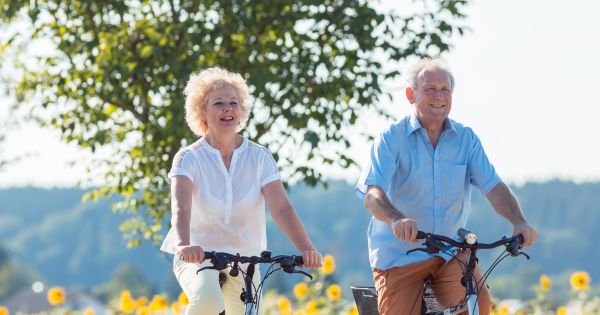Maintaining an active lifestyle as we age is vital. Often likened to a fine wine that improves over time, human life can be rich and satisfying in the later years if we invest in our health. Today, we are spotlighting the importance of physical activity in ageing and the different strategies to integrate it into your life.

The Power Of Staying Active
Staying active isn’t merely about keeping fit; it’s a holistic approach to life that benefits our mind, body, and spirit. The positive ripple effects of maintaining an active lifestyle, particularly as we age, are boundless.
Engaging in regular physical activity mitigates the risk of various health conditions, such as high blood pressure, high cholesterol, type 2 diabetes, heart disease, bone issues like osteoporosis, obesity, and even some types of cancer. Additionally, being active has a profound influence on mental health, promoting improved sleep quality, mood enhancement, stress reduction, and diminished pain from conditions like arthritis.
Conversely, a sedentary lifestyle can potentially compound health risks. Thus, breaking up long periods of sitting with even a few minutes of physical activity can be hugely beneficial.
Ageing Gracefully: Physical Activity And Ageing
Can physical activity ‘slow down’ the ageing process? The answer is a resounding yes. Certain types of physical activities, like resistance training and flexibility exercises, can help to alleviate the physical changes that accompany ageing.
As we age, most people experience some loss in muscle mass, bone density, and flexibility. Chronic health problems can exacerbate these issues, contributing to weakness and frailty. However, regular physical activity has been shown to enhance overall health, reduce the chance of chronic health conditions, and decrease frailty. This means as we age, staying physically active becomes increasingly important for maintaining a high quality of life and potentially even extending our lifespan.

Guidelines For Physical Activity In Older Age
To stay active and healthy, older individuals should aim for approximately 30 minutes of moderate-intensity physical activity daily. Exercise should be stimulating but not exhausting – if you’re slightly breathless but can still converse comfortably, you’re on the right track.
It’s beneficial to diversify your physical activities to keep your routine interesting and sustainable. Let’s delve into the different types of exercises suited to older individuals.
Cardiovascular Fitness Activities
Cardio fitness exercises support heart and lung health. These include brisk walking, cycling, swimming, golf (without a golf cart), tennis, aerobics classes, and dancing. Even household chores like gardening and cleaning can be considered great cardio workouts. Low-impact activities such as swimming can be particularly beneficial for those who find movement painful due to health conditions like osteoarthritis.
Strength Activities
Strength activities help to keep your muscles and bones robust. Strength training and weight-bearing exercises can significantly increase bone density and reduce the risk of falls among individuals with osteoporosis. Strength exercises include weight training, resistance training, lifting and carrying (for example, groceries), gardening (involving digging and lifting), and stair climbing.
Flexibility And Balance Activities
Flexibility exercises incorporate gentle stretching and bending exercises that enhance mobility. Balancing activities help to improve stability, which can aid in fall prevention. Both types of activities are vital for maintaining an active and injury-free lifestyle. Examples include Tai Chi, yoga, dancing, and side leg raises.
All these types of exercises can be varied and performed outside of a gym or class setting. There are numerous online fitness tools and programs available that you can use at home.
For individuals with restricted mobility or disabilities, exercise programs can be tailored to their specific needs. In fact, even those experiencing foot or leg pain or discomfort can find solutions in targeted treatments. For instance, services offered by a reputable Sydney podiatry clinic have proven beneficial in alleviating foot-related issues.
Safely Starting Exercise in Later Years
If you’re new to regular exercise, it’s crucial to start gradually, allowing your body time to adjust to the new routine. Begin with short periods of activity and build up to the recommended 30 minutes over several weeks. Ensure that you wear comfortable clothing and supportive shoes, and remember to stay hydrated before, during, and after exercising.
If you have been inactive due to a health condition or recent surgery, consult your doctor before restarting your fitness program. You might be referred to a physiotherapist or exercise physiologist for advice.
While physical activity should involve some effort, it should not cause pain. If you experience pain or other symptoms such as dizziness or heart palpitations when you exercise, stop the activity and seek medical advice.
Staying Motivated
Staying motivated can be challenging. However, by choosing activities you enjoy, inviting a friend or family member to join you, using reminders, scheduling regular exercise times, and recording your activities, you can help maintain your motivation.
IMAGE
Debunking Myths About Physical Activity And Older People
Many seniors are finding that gyms and exercise classes are great ways to maintain their health and fitness. With classes and equipment designed specifically for older individuals, these options provide a safe and supportive environment for seniors to stay active and healthy.
Similarly, treatments such as the NQ Physio sports injury treatment have been effective in addressing seniors, encouraging individuals to get back into an active lifestyle. Even those who are frail or dealing with health problems can find safe and enjoyable ways to stay active. Physical activity can help you become stronger and less frail. Remember, it’s never too late to become more active. Improving your fitness and mobility, even at an older age, will boost your physical and mental health, as well as your quality of life.
In conclusion, staying active as you age is not just about adding years to your life, but also adding life to your years. It’s about embracing a preventative rehabilitation approach to aging, keeping you fit, healthy, and energetic. Enjoy your golden years with vitality and vigor – you’ve earned it!
 Kaboutjie SA Mommy Blogs by Lynne Huysamen
Kaboutjie SA Mommy Blogs by Lynne Huysamen




